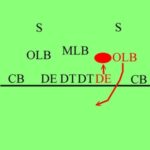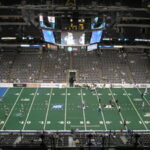If you’ve watched any NFL game in the last decade you almost undoubtedly heard the phrase “Cover 2 defense”. However, announcers and commentators rarely take the time to explain the concept beyond a rudimentary level. From casual fans on to even serious NFL devotees, few can accurately describe the true nature of this defensive scheme, and it’s descendant which is commonly used throughout the league now, The Tampa 2.
The term “Cover 2” derives from the defensive strategy of separating the deep half of the field (starting at about 15 yards from the line of scrimmage) into two zones. Each of these deep zones is played by one of the safeties. Bud Carson, defensive coach for the Steelers “Steel Curtain” teams is said to have been the originator of this scheme. The four defensive linemen rush the quarterback, while the three linebackers and two cornerbacks separate the part of the field in front of the safeties into five smaller zones. Therefore, the Cover 2 is an entirely zone defense (no man-to-man coverage) that is deployed out a basic 4-3 personnel set (4 linemen, three linebackers).
The major weakness of the base Cover 2 was the middle of the field once you got beyond 10 or 15 yards from the line of scrimmage. Tony Dungy, now a Super Bowl winner and coach of the Indianapolis Colts, adapted the Cover 2 he learned while playing for Carson. In his new Tampa 2 (he instituted the system while coach of the Tampa Bay Buccaneers), the middle linebacker’s zone of coverage would extend deep into the middle of the field, closing off that opening. In essence, this makes the system a “cover 3”, as in the deep part of the field is separated into 3 separate zones. With the faster, more athletic linebackers of today’s NFL this is much easier to pull off. Brian Urlacher of the Chicago Bears is the perfect example of the type of player that makes the Tampa 2 shine and achieve maximum success. Depending on the routes run and number of receivers used, the cornerbacks in this scheme will generally try to force the receiver toward the center of the field where more coverage awaits.
The Tampa 2 was originally designed to defend against the West Coast Offense – lots of short passes, quick routes and a minimal running game. The first remaining flaw in the Tampa 2 is the soft spot on the each sideline, between the shallow zone of the cornerback and the deep zones of the safety. The second flaw is that you are completely reliant on your four defensive linemen to create pressure on the quarterback. With athletic and smart players, and the right grouping of personnel, these flaws can be reduced significantly. The best remaining way to beat the Tampa 2 defense is with a power running game. Building off the running game and creating play-action scenarios (faking a running play then dropping back into a passing play) makes the middle linebacker and safeties draw in closer to the line of scrimmage, leaving openings downfield.
Every single team in the NFL has and uses some form of the Cover 2, or Tampa 2 as a defensive strategy. Many of those teams employ that style of coverage as their base defense, meaning that is what they use the majority of the time. As is the case in the NFL, times change and teams adapt. As more offensives become equipped to beat the Tampa 2 defense, more defenses will change, creating the unending cycle of evolution that the league is famous for.
As the 2007 NFL season approaches, keep a look out for more pieces explaining other prevalent NFL strategies, including the aforementioned West Coast offense and the differences between a 4-3 and 3-4 defense.





